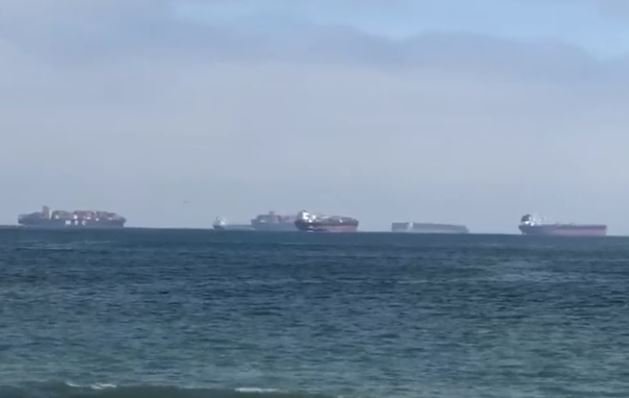Guest post
We’ve been hearing a lot about the throngs of cargo ships backed up in the Pacific Ocean outside of the ports of Los Angeles and Long Beach. Reports of up to 100 ships anchored in authorized anchorage areas and some just drifting under power outside of the authorized anchorage area are crowding the San Pedro and Santa Monica basin. We’ve reported on this recently.
The recent massive oil spill off the Orange County coast is suspected to be the possible cause of a cargo ship’s anchor dragging and gashing an oil pipeline line between the “Emmy” off-shore platform and the Long Beach refinery.
The 3 “official” anchorages off the coast are designed to handle 1-3 ships each while they wait for a berth at the LA and Long Beach ports. Currently, according to the website Marinetraffic.com, there are sometimes 8-12 ships in each of these anchorages and many more ships drifting under power just outside the anchorage areas. This area is under the 24-hour guidance of the Marine Exchange of Southern California (https://mxsocal.org) who, according to their website, “utilizes a state-of-the-art, comprehensive, computerized database system to provide vital statistics and information on ships calling at the four major ports in Southern California”.
Authorized anchorage areas are designed to avoid undersea hazards and assets such as oil pipelines and undersea fiber optics cables, but the excessive volume of ships and berth wait time could be causing a dangerous excess of the safe capacity of these near-shore areas.
The bulk of all of the world’s internet and voice data travels over undersea fiber optic cables. These cables are vulnerable to disruption risks including damage by dragging ship anchors. The US Director of National Security includes this risk in a September 2017 report called “Threats To Undersea Cable Communications”.
Some of these cables have onshore landing points in the same location as the oil pipeline. The Unity/EAC Pacific cable (owned by Airtel, Google, Singtel, and Telstra) comes onshore in Redondo Beach, CA and connects to Japan. The Jupiter cable (owned by Amazon Web Services, Facebook, NTT, and Softbank) comes onshore at Hermosa Beach, CA as does the SEA-US cable (owned by Globe Telecom, Hawaii Telcom, and RTI). The Southern Cross cable (owned by ASN and Fujitsu) connects the West Coast of the US with Hawaii, Australia and New Zealand and comes onshore at Morro Bay, CA, as does the Japan-US Cable (owned by AT&T, China Telecom, Singtel, NTT, SOftbank, T-Mobile, Verizon, Telstra and other). The Pacific Light Cable Network (owned by Facebook and Google) comes onshore at El Segundo, California and connects to the Philippines and Taiwan.
Undersea cable faults and ruptures have caused Internet and telecommunications outages all over the world, as recently as October 11 in Pakistan as reported by Insiderpaper.com
A report in Network World indicates that “internet-carrying cables are susceptible to cuts and are an accident waiting to happen”. Damage to one or more of these cables could cause catastrophic disasters, such as bringing down the global financial system or crippling a nation’s commerce functions.
When most people talk or think about the internet or the ‘cloud,’ they imagine that data is being transferred effortlessly through the skies or satellites.” “The reality is that 97 percent of worldwide communications is transmitted by the barely protected half-million miles of fiber cables lying on ocean beds.” They carry $10 trillion in financial transfers per day, claims study author Rishi Sunak.
The post Overstressed Cargo Ship Logjams Could Inadvertently Cause Communications Outage – Is Biden Prepared? appeared first on The Gateway Pundit.



